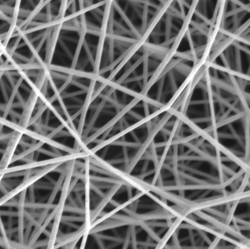Scientists at Contipro have created materials that can be programmed to function for a specific duration in the body before being fully absorbed. They have also developed the new apparatus 4SPIN, capable of creating structured nanofibers from such materials.
 Nanofibres form biopolymer
Nanofibres form biopolymer
Hyaluronic acid is a common ingredient in cosmetic creams, eye drops or injections improving the functioning of joints with damaged cartilage. Now, not only are scientists able to produce nanofibers from this substance, but they can also program how long they are to last in the body. What makes “programmable” nanofibers from biopolymers so beneficial? They serve all manner of purposes, from new cartilage to the repair of damaged nerves.
“The main advantage of the new materials is that they are biocompatible and biodegradable materials which do not cause allergic reactions. What is more, they can be treated so that, once their designated active period ends, they are fully absorbed. Imagine that you have several patients. One lost cartilage in his knee following an accident, the second has injured wrist tendon, and the third is about to undergo an appendectomy. We need a different type of material for each of them. After surgery, in the abdominal cavity you need a separating membrane to prevent unwanted adhesions for just a week. With the knee cartilage, you need resistant material in the form of scaffold, sown with the patient's own cartilage cells, for at least a month. As for the tendons, all fibers must be perfectly arranged in the same direction in order to achieve strength. You must therefore have materials that can be programmed to decay and a device capable of creating nanofibers from biopolymers and structuring them as required. And that is where we have succeeded,” says Vladimír Velebný, CEO of Contipro, as he explains the benefits.
How come 4SPIN, the new device for creating nanofibers, has been produced by a company better known for its research and development of raw materials for the pharmaceutical and cosmetics industry? “Our original intention was to create a scaffold using the human body's own material and then to stitch cells onto it. Well-designed scaffolding would provide support for cells and give them signals about how to organize and develop, and how to create a graft to replace the patient's damaged tissue without obstructing the body once healing was complete. The task for the scientists was therefore clear – to spin hyaluronan and structure the fibers. However, there was no equipment on the market that was capable of this, so we developed it ourselves. The result is so good that it would be a shame to keep it to ourselves in our own laboratory. Therefore, we want to offer it to universities and innovative companies,” says Velebný.
The synergy of the new apparatus and programmable materials is natural. Contipro is a world leader in the chemistry of hyaluronan (hyaluronic acid), as evidenced by its online catalogue of specialty hyaluronan chemicals for research purposes.
Hyaluronan is a substance that is already present in the human skin, ensuring the smooth movement of our joints, and forming a significant part of the eye. The effects of this substance vary depending on the length of the molecule. For instance, the longest chains are used for skin hydration in cosmetics, whereas the shortest hyaluronan chains are being investigated as a promising means of drug delivery.